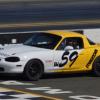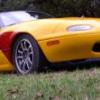"Tuned" AFM?
Some tuned AFM are just horrible - coughing, backfiring, smoke-spewing, etc. But there also a lot of 1.6s that are much MORE horrible in terms of maintenance and being in specification on the rest of the idle system. There are about 20 things that can go wrong that will make a tuned AFM cause idle cycling, high idles, etc.
A properly tuned AFM installed on a healthy 1.6 will likely result in a high, but steady, idle.
Step 1: Fully turn down the idle bypass screw at the throttle plate.
Step 2: Adjust the throttle plate stop to the bare minimum. This is a 3-handed job that must be done with the throttle at WOT.
Step 3: The pedal stop on the firewall must be adjusted to avoid "stretching" the throttle cable and twisting the throttle shaft. I'll estimate that 80% of SMs that have been through an engine swap have this failure mode.
*Tuned AFM Technical Notes*
Fast idle or idle cylcing is "normal behavior" on cars with other items out of spec or damaged - but if the throttle position sensor, throttle plate position (idle stop), throttle plate air bypass, throttle dashpot, throttle pedal stop (on floorboard), and ignition timing - are all correctly adjusted, the car should idle perfectly with a properly tuned AFM. This cycling high idle is the Idle Air Control valve trying to compensate for a fast idle and since it is still too fast, the ECU cuts off the engine to avoid a runaway idle. The cycling behavior will NOT affect torque, horsepower, or air-fuel ratio under race or dyno conditions. But, the fast idle will potentially be "fighting" you under braking. The shortest fix is to crank down the air bypass at the throttle plate, and adjust the throttle plate idle screw so that the throttle plate closes as far as it can without "sticking". If this doesn't succeed at lowering the idle to 800-900, look for a twisted throttle shaft, leaking throttle shaft, vacuum leaks, or the throttle-anti-slam-closed dashpot holding the throttle open at idle. (Note: The dashpot gets "flexed" down in major crashes. Look for witness marks on the underside of the hood to find out if your car has been in a severe crash). The throttle pedal MUST bottom on the floorboard stop without stretching the throttle cable and twisting the throttle shaft. Many cars have this screwed up from engine changes - because the throttle cable distance is affected by where the throttle cable is mounted to the intake manifold.
Fuel pressure and Adjustable Fuel Pressure Regulators: Tuned AFMs that are not tuned on the dyno on your car assume "stock" fuel pressure of 37-39 psi, with a small margin to assure the motor doesn't run too lean. Verify your fuel pressure and correctness of AFPR installation by monitoring fuel pressure on the dyno or track.
The other clue is to check the idle speed when fully warmed up, and then check it again with the TEN and GND pins shorted. When everything is in spec, the idle will be the same. If there is a difference, it means the IAC valve is having to work to keep teh idle down - and once the tuned AFM is introduced into this situation, it can produce fast idle and cycling idle.




 Sign In
Sign In Create Account
Create Account







 Back to top
Back to top Report
Report














